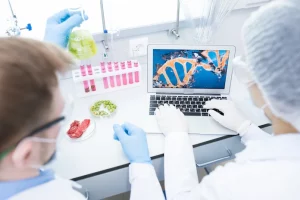Reactive oxygen species, i.e. free radicals, are commonly associated with something harmful; such statements, however, are not entirely true. Free radicals play an important role in maintaining the homeostasis of the body. Their impact is determined by their amount in the body – only their excess they can cause problems. Let us take a closer look at what free radicals are, and what their are responsible for.
What are free radicals and what are their functions in your body?
Free radicals are formed in the process of cellular respiration, an action vital for the creation of energy in the cell. Their formation can also be initiated by other processes, e.g. ionizing or ultraviolet radiation, ultrasounds, oxidative stress.
Free radicals are basically atoms or molecules that exist alone and have one or more unpaired electrons. These electrons make the molecule very reactive. The molecule “wants” to get rid of the excess electron or “take” a similar one from another particle.

Free radicals are various chemical compounds, but the most common are oxygen compounds (Reactive Oxygen Species, ROS) and nitrogen compounds (Reactive Oxygen and Nitrogen Species, RONS). Examples of common compounds include:
- peroxide radical,
- hydroperoxide radical,
- nitrogen dioxide,
- superoxide anion radical,
- nitric oxide,
- singlet oxygen,
- hydroxyl radical,
- hydrogen peroxide,
The process of formation of free radicals is vital for the body due to they regulatory abilities of numerous processes that are present within the cell.
Important functions of free radicals in the body
The presence of free radicals has influence on growth, differentiation and finally programming of the cell death (apoptosis). Thanks to them, the synthesis, release and inactivation of nitric oxide is correct. What is more, free radicals regulate the transport of glucose into cells as well. One of their most important functions is the regulation of signal transmission both within a single cell and between different cells. Without the existence of free radicals, our body would not be able to cope with the various pathogens that come into contact with it on a daily basis. The cells of the immune system responsible for dealing with phagocytosis, i.e. the absorption and digestion of large particles (e.g. bacteria), are activated when their receptors come into contact with the pathogen and a specific process called “oxygen burst” launches in them. As a result, free radicals are created in the form of superoxide anion radicals. Subsequently, they undergo further reactions, leading to the formation of hydroxyl radicals, hypochlorites, or hypobromites. They constitute an effective defence mechanism inside our cells. Additionally, the researchers noted that T-cells use reactive oxygen species to regulate immune signalling and migration to inflamed areas.
Thus, as can be observed, the right and physiologically safe amount of free radicals is necessary for our body to function. The problem arises when – under the influence of internal and external factors – free radicals are overproduced.
Additionally, the researchers noted that T-cells use reactive oxygen species to regulate immune signalling and migration to inflamed areas.
Thus, as can be observed, the right and physiologically safe amount of free radicals is necessary for our body to function. The problem arises when – under the influence of internal and external factors – free radicals are overproduced.
What damage can excess free radicals cause?
DNA damage will translate into disorders of DNA replication processes, namely the duplication without errors in the process of creating new cells. The consequence of errors in DNA is the incorrect process of transcription of genetic information when creating new proteins in the cell, which disturbs its structural and metabolic functions.

What is oxidative stress?
Oxidative stress, i.e. a disturbance in the balance between the intensity of processes inducing the formation of reactive oxygen species and the antioxidant capacity of the body, is a dangerous phenomenon for our body. As we have already mentioned, cell membranes, proteins in cells or DNA can be damaged as a result. This translates into systems such as the circulatory system, respiratory system, digestive system and nervous system being affected.
Excessive oxidative processes, especially those long-lasting ones, can contribute to the formation of such serious diseases as degenerative diseases (Alzheimer's disease or Parkinson's disease), degenerative diseases (e.g. joint diseases), inflammatory diseases (hepatitis, pancreatitis) or cancer.
The very oxidation (peroxidation) of cell membrane lipids causes a change in the permeability of the cell membrane, disruption of energy processes in the mitochondria and may even result in cell death. On a macro scale, damage by free radicals to the endothelium of blood vessels can contribute to the development of atherosclerosis.
The body’s defence mechanisms vs. the excess of free radicals
Our body has developed defence systems against oxidative stress, conditioning the balance in the amount of free radicals.
The first system is called the enzymatic antioxidant mechanism. Special enzymes are there to prevent and reduce the existing reactive oxygen species. These enzymes are:
- SOD, i.e. superoxide dismutase that protects the cell against the harmful effects of peroxides;
- CAT, or catalase that breaks down hydrogen peroxide into water and oxygen;
- Gpx, or glutathione peroxidase, a selenoenzyme that reduces hydrogen peroxide and organic peroxides.
They constituting our first line of defence and are supposed to prevent the chain of reactions that produce free radicals from starting.
The non-enzymatic antioxidant mechanism is also involved in breaking the reaction chain. For its operation, an antioxidants supplied to the body with food are needed. These include the well-known vitamins, e.g. vitamin C, vitamin A (beta-carotene) and vitamin E. Minerals are also important, e.g. selenium, zinc and copper. Plant polyphenols play an important role as well. Endogenous compounds such as uric acid, glutathione or estradiol derivatives also play a role in this mechanism. The action of these substances is the second line of defence.
The important role of antioxidants
The mechanism of action of antioxidants is that they give the free radical molecule the electron it lacks. They do this before the free radical takes it from another, physiologically vital molecule, i.e. DNA, enzyme or lipid. Thanks to this, antioxidants are able to protect these vital elements for the body.
Antioxidants constitute a component of a healthy, unprocessed diet. We find them mainly in fruits and vegetables. Herbal spices and tea, coffee or herbal infusions used in everyday cooking are also a rich source of them. Antioxidants can also be found in seeds and nuts, as well as cold-pressed unrefined oils.
The combination of the action of the two above-mentioned antioxidant mechanisms: the antioxidant and non-enzymatic mechanism gives us the best defence against excess free radicals in the body.
The last, third element of the protective system, are the mechanisms for removing molecules damaged by free radicals or, if possible, responsible for repairing the damage. For example, the DNA polymerase enzyme participates in the repair of genetic material.
Free radicals. Summary
It is important to remember that the presence of free radicals in the body is not inherently a bad thing. As we explained, they have an important role to play in regulating the body’s homeostasis. Only their excess can result in negative consequences in the form of oxidative stress, which can be the cause of many diseases.
The times in which we live offer many civilization achievements that make our everyday life easier. The other side of this progress, however, is the greater number of toxic factors that generate excess free radicals in our body.
It is, therefore, worth remembering the importance of maintaining a healthy lifestyle and incorporating a daily menu with the necessary portion of antioxidants from vegetables, fruits, or herbs.
Marta Koziarska – pharmacist with extensive experience, in the profession since 1998. An extremely inquisitive person with a sense of mission, a supporter of searching for the causes of illness and holistic medicine. She calls herself the “Sherlock Holmes of medicine”. Author of numerous publications, deputy editor-in-chief of the Radioklinika.pl portal.
Literature
- Kulbacka J, Saczko J, Chwiłkowska A, Stres oksydacyjny w procesach uszkodzenia komórek, Polski Merkuriusz Lekarski, 2009, 157(44), s.44-47;
- Zabłocka A, Janusz M, Dwa oblicza wolnych rodników tlenowych, Postepy Hig Med Dosw, 2008, 62, s. 118-124;
- Karbarz M, Źródła powstawania i oddziaływanie środowiskowe wolnych rodników, Zeszyty Naukowe SGSP, 40, s. 59-67;
- Skotnicka M, Golan M, Szmukała N, Rola naturalnych przeciwutleniaczy pochodzenia roślinnego w profilaktyce nowotworowej, Ann. Acad. Med. Gedan. 2017, 47, s. 119-127;
- Białek M, Czauderna M, Budowa chemiczna oraz funkcje fizjologiczne wybranych antyoksydantów, Instytut Fizjologii i Żywienia Zwierząt im. Jana Kielanowskiego Polskiej Akademii Nauk, Jabłonna 2016;
- Puzanowska-Tarasiewicz H, Kuźmicka L, Tarasiewicz M, Antyoksydanty a reaktywne formy tlenu, BROMAT. CHEM. TOKSYKOL. – XLIII, 2010, 1, s. 9-14;
- Oliński R, Jurgowiak M, Żelazo, wolne rodniki i oksydacyjne uszkodzenia DNA a choroba miażdżycowa, Via Medica, 2002, 8(2), s. 37-44;
- Czajka A, Wolne rodniki tlenowe a mechanizmu obronne organizmu, Nowiny Lekarskie, 2006, 75(6), s. 582-586;
- Czerwiecki L, Współczesne poglądy na rolę przeciwutleniaczy roślinnych w profilaktyce chorób cywilizacyjnych, ROCZN. PZH 2009, 60 (3), s. 201 – 206;
- http://www.e-biotechnologia.pl/Artykuly/Enzymy-antyoksydacyjne/.